- 31 MAI
- FRANCE – 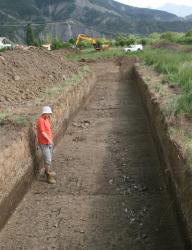
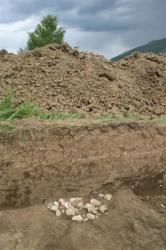 Veynes - L’archéologie moderne sait prendre les devants. C’est ainsi qu’est récemment intervenue une équipe de l’Inrap dans un site dévolu ultérieurement à des constructions, au sud de Veynes, près du hameau de Saint-Marcellin. Aidés d’une pelle mécanique imposante, mais capable de réaliser des décapages “chirurgicaux”, les archéologues ont ausculté le sous-sol sur une étendue de plusieurs milliers de mètres carrés, en effectuant une quinzaine de vastes excavations rectangulaires et, rien n’échappant à leur vigilance, ils ont pu repérer des dizaines de structures d’habitat : foyers, cuvettes de combustion, fosses-silos, fosses de rejets, aires empierrées, un fossé et son remplissage, ainsi que de probables trous de poteaux, à une profondeur voisine de deux mètres. Des vestiges abandonnés au sein de ces structures ou sur les sols d’habitat permettent une première approche culturelle et chronologique : il s’agit principalement de tessons de poterie, de silex (éclats, outils, pointes de flèches) et de charbons de bois qui amènent déjà à attribuer l’occupation principale du site à une phase finale du néolithique (lire ci-dessous). Un autre niveau bien distinct, plus superficiel puisque plus récent, correspond à une occupation ponctuelle de l’âge du bronze (autour de 1000 ans avant notre ère). Un rapport scientifique est transmis à la Drac (direction régionale des affaires culturelles), plus précisément au service régional de l’archéologie. C’est une découverte importante pour les Hautes-Alpes, car les habitats de plaine de cette période sont très mal connus dans le département. Régionalement aussi, ce site est un jalon qui permettrait de préciser les spécificités culturelles, par exemple provençales, italiques ou rhônalpines, qui caractériseraient alors ce territoire à l’aube de l’Histoire, 3 000 ans avant J.C
Veynes - L’archéologie moderne sait prendre les devants. C’est ainsi qu’est récemment intervenue une équipe de l’Inrap dans un site dévolu ultérieurement à des constructions, au sud de Veynes, près du hameau de Saint-Marcellin. Aidés d’une pelle mécanique imposante, mais capable de réaliser des décapages “chirurgicaux”, les archéologues ont ausculté le sous-sol sur une étendue de plusieurs milliers de mètres carrés, en effectuant une quinzaine de vastes excavations rectangulaires et, rien n’échappant à leur vigilance, ils ont pu repérer des dizaines de structures d’habitat : foyers, cuvettes de combustion, fosses-silos, fosses de rejets, aires empierrées, un fossé et son remplissage, ainsi que de probables trous de poteaux, à une profondeur voisine de deux mètres. Des vestiges abandonnés au sein de ces structures ou sur les sols d’habitat permettent une première approche culturelle et chronologique : il s’agit principalement de tessons de poterie, de silex (éclats, outils, pointes de flèches) et de charbons de bois qui amènent déjà à attribuer l’occupation principale du site à une phase finale du néolithique (lire ci-dessous). Un autre niveau bien distinct, plus superficiel puisque plus récent, correspond à une occupation ponctuelle de l’âge du bronze (autour de 1000 ans avant notre ère). Un rapport scientifique est transmis à la Drac (direction régionale des affaires culturelles), plus précisément au service régional de l’archéologie. C’est une découverte importante pour les Hautes-Alpes, car les habitats de plaine de cette période sont très mal connus dans le département. Régionalement aussi, ce site est un jalon qui permettrait de préciser les spécificités culturelles, par exemple provençales, italiques ou rhônalpines, qui caractériseraient alors ce territoire à l’aube de l’Histoire, 3 000 ans avant J.C
http://www.ledauphine.com/hautes-alpes/2011/05/30/des-vestiges-datant-d-il-y-a-5000-ans
- ALGERIE – 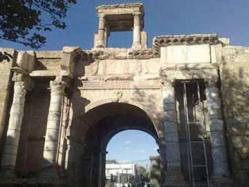 Tébessa - Les travaux de restauration des trois monuments des sites archéologiques romains de Tébessa, à savoir la porte de Caracalla, la porte de Chella et l’huilerie de Berzguen, suspendus en 2005 par une commission ministérielle au motif d’utilisation de matière non conforme à l’époque, ne reprendront pas. Le projet est définitivement clos. Aujourd’hui, la wilaya de Tébessa qui recèle plus d’une centaine de sites archéologiques, voit le dépérissement total de son patrimoine. L’on apprend aussi que l’huilerie de Berzguen, située à quelques encablures de la commune d’El Ma labiod, à 45 km au sud de la wilaya, construite au début du IIIe siècle av. J.-C, et qui fut l’une des plus grandes d’Afrique, se trouve actuellement en ruine après que ses linteaux et colonnes se sont effondrés lors d’une tempête.
Tébessa - Les travaux de restauration des trois monuments des sites archéologiques romains de Tébessa, à savoir la porte de Caracalla, la porte de Chella et l’huilerie de Berzguen, suspendus en 2005 par une commission ministérielle au motif d’utilisation de matière non conforme à l’époque, ne reprendront pas. Le projet est définitivement clos. Aujourd’hui, la wilaya de Tébessa qui recèle plus d’une centaine de sites archéologiques, voit le dépérissement total de son patrimoine. L’on apprend aussi que l’huilerie de Berzguen, située à quelques encablures de la commune d’El Ma labiod, à 45 km au sud de la wilaya, construite au début du IIIe siècle av. J.-C, et qui fut l’une des plus grandes d’Afrique, se trouve actuellement en ruine après que ses linteaux et colonnes se sont effondrés lors d’une tempête.
http://www.elwatan.com/regions/centre/actu-est/les-travaux-a-l-arret-31-05-2011-126642_221.php
- AUSTRALIE – 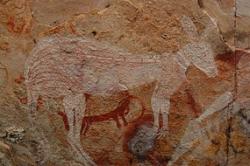 - A campaign will be launched today to help save and document thousands of Aboriginal rock art sites around Australia.It is thought there may be as many as 100,000 separate works spread throughout the country, but a full count has never been carried out. Experts fear unless a national register is created, half the rock art sites could be lost to industry, urban development and vandalism. Rock art sites can be found all around the country, from inner-city Sydney to the Northern Territory, Western Australia and Tasmania. Some are 15,000 years old. "There are drawings, paintings, stencils, figures made of beeswax pressed onto the wall, all sorts of different types of engravings," Professor Tacon said. "Some of them are very sort of simple and basic, others are elaborate creations that would have taken hours, if not days, to produce." While it is estimated there are as many as 100,000 examples of rock art, no-one really knows for sure. "This is part of the problem, we don't actually know how many sites we have," Professor Tacon said. "Australia has never had a central database, any sort of archive or register of sites, unlike many other countries. And one of our objectives is to produce something like this, to draw together the little bits and pieces, the records in various government departments and museums and private hands and universities, so that we get a picture, a snapshot, of this amazing heritage resource." The plan is to create a national digital rock art register archive combining the resources of centres at the ANU, Griffith University and the University of Western Australia. "One of the first things we want to do is identify the top 100 sites in the country and then produce laser scans so that we can have 3D replications of those sites so if anything does happen to them, we've got this record," Professor Tacon said. He says there are a wide range of threats to Australian rock art sites.
- A campaign will be launched today to help save and document thousands of Aboriginal rock art sites around Australia.It is thought there may be as many as 100,000 separate works spread throughout the country, but a full count has never been carried out. Experts fear unless a national register is created, half the rock art sites could be lost to industry, urban development and vandalism. Rock art sites can be found all around the country, from inner-city Sydney to the Northern Territory, Western Australia and Tasmania. Some are 15,000 years old. "There are drawings, paintings, stencils, figures made of beeswax pressed onto the wall, all sorts of different types of engravings," Professor Tacon said. "Some of them are very sort of simple and basic, others are elaborate creations that would have taken hours, if not days, to produce." While it is estimated there are as many as 100,000 examples of rock art, no-one really knows for sure. "This is part of the problem, we don't actually know how many sites we have," Professor Tacon said. "Australia has never had a central database, any sort of archive or register of sites, unlike many other countries. And one of our objectives is to produce something like this, to draw together the little bits and pieces, the records in various government departments and museums and private hands and universities, so that we get a picture, a snapshot, of this amazing heritage resource." The plan is to create a national digital rock art register archive combining the resources of centres at the ANU, Griffith University and the University of Western Australia. "One of the first things we want to do is identify the top 100 sites in the country and then produce laser scans so that we can have 3D replications of those sites so if anything does happen to them, we've got this record," Professor Tacon said. He says there are a wide range of threats to Australian rock art sites.
http://www.abc.net.au/news/stories/2011/05/31/3231466.htm
- ABU DHABI – 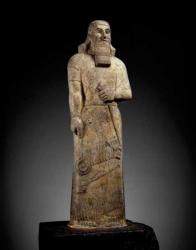 Saadiyat Island – Splendours of Mesopotamia. This exhibition of about 200 objects from ancient Mesopotamia has been organised by the British Museum (BM) for Abu Dhabi’s Tourism Development & Investment Company, the first of three planned exhibitions heralding the opening on Saadiyat Island of the Zayed National Museum, due to be completed by 2014. Nigel Tallis, the curator of later Mesopotamia at the BM, said that it will be the first large archaeological exhibition to be held in the area. Rare objects, including items from Babylon, and a stone statue of King Ashurnasirpal II from Nimrud would not normally leave the London museum. Many of the objects excavated in the 19th century were key to the founding of the study of ancient and near eastern history.
Saadiyat Island – Splendours of Mesopotamia. This exhibition of about 200 objects from ancient Mesopotamia has been organised by the British Museum (BM) for Abu Dhabi’s Tourism Development & Investment Company, the first of three planned exhibitions heralding the opening on Saadiyat Island of the Zayed National Museum, due to be completed by 2014. Nigel Tallis, the curator of later Mesopotamia at the BM, said that it will be the first large archaeological exhibition to be held in the area. Rare objects, including items from Babylon, and a stone statue of King Ashurnasirpal II from Nimrud would not normally leave the London museum. Many of the objects excavated in the 19th century were key to the founding of the study of ancient and near eastern history.
http://www.theartnewspaper.com/whatson/event/Splendours-of-Mesopotamia/1118535
- ROYAUME-UNI – 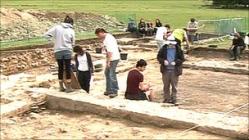
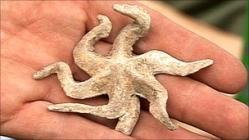 Leeds - Hundreds of artefacts dating from the Middle Ages to the 18th Century have been discovered by archaeology students working at Harewood House in Leeds. The students, from York University, have excavated the remains of Gawthorpe Hall, a medieval manor in the grounds of what is now Harewood House. The items found include a 15th Century coin and an 18th Century chamber pot. It is hoped the finds will give fresh insight into the origins of Harewood House, which was finished in 1771. Gawthorpe Hall was demolished by 1773, its remaining traces filled with rubble and covered with turf. There are quite a lot of expensive ceramics coming from the main house, but we are also getting an idea about how the ordinary servants would have lived." The remnants of Gawthorpe Hall have been revealed for the first time since its demolition in the 1770s. Other artefacts discovered by the students include a gilt star, decorative glassware, wine bottle fragments and even a flint arrowhead dating back to pre-history.
Leeds - Hundreds of artefacts dating from the Middle Ages to the 18th Century have been discovered by archaeology students working at Harewood House in Leeds. The students, from York University, have excavated the remains of Gawthorpe Hall, a medieval manor in the grounds of what is now Harewood House. The items found include a 15th Century coin and an 18th Century chamber pot. It is hoped the finds will give fresh insight into the origins of Harewood House, which was finished in 1771. Gawthorpe Hall was demolished by 1773, its remaining traces filled with rubble and covered with turf. There are quite a lot of expensive ceramics coming from the main house, but we are also getting an idea about how the ordinary servants would have lived." The remnants of Gawthorpe Hall have been revealed for the first time since its demolition in the 1770s. Other artefacts discovered by the students include a gilt star, decorative glassware, wine bottle fragments and even a flint arrowhead dating back to pre-history.
http://www.bbc.co.uk/news/uk-england-leeds-13602503